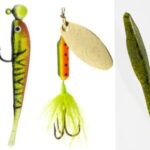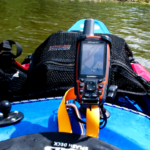Spinnerbait Basics – Tips to Catch More Bass

A spinner bait is one of the most popular and now iconic lures in the bass fishing industry. Spinner baits really caught fire the 60s and quickly dominated with their effectiveness.
According to Wikipedia hey spinner bait is defined as; a family of fishing lures that get their name from one or more metal blades shaped so as to spin like a propeller when the lure is in motion, creating varying degrees of flash and vibration that mimic small fish or other prey.
Spinnerbaits attract numerous predatory fish. Although, the most common may very well be bass. Spinner baits have grown in popularity because of their innate ability to mimic pods of baitfish.
Similarly to fishing crankbaits for bass, spinnerbaits can be tweaked, tuned, and manipulated to have tremendous success on the water.
A spinnerbait can have various shapes, sizes, weights, blades, skirts, and trailers. Adjusting these components allows for specific targeting of bass Depending on weather and water conditions.
Basic spinnerbait blades
In the world of spinner baits there are three predominate blades throughout the industry. These three blades include the Willow leaf blade Colorado blade in Indiana blade. Spinnerbait blades offer flash, vibration, and movement. Let’s cover these in a little more detail.
Willow leaf blades
By design Willow leaf blades run at higher speeds then there are other counterparts. The longer taper allows for the blade to act more true when coming through the water. This is it to say that Willow leaf blades cannot be retrieved slowly. Smaller, wider, less carpet blades have the ability to run slower through the water.
Willow leaf blades are generally ran in tandem with other blades. Designed for faster retrieves these blades offer maximum flash. Willow leaf blades can be ran in tandem with another willow leaf blade, a Colorado blade, or Indianna blade.
Colorado blade
The uniqueness about the Colorado blade is it’s rounded design. With it’s almost circular shape and cupping these blades allow for a much slower retrieve.
Colorado blades by design create vibration more so than Willow leaf blades.
Often times anglers will use Colorado blades On spinnerbaits around dense vegetation, low visibility water conditions, or night time. They are equally as powerful and down timber, rocky shoreline, and mats.
Indiana Blades
The Indiana blade has a more tear drop shape. These blades were designed to be used under moderate water conditions.
The shape of the Indiana blade offers an ability to be retrieved at moderate speeds. That speed just between the willow leaf blade and the Colorado blade.
They offer more flash than a Colorado, but less than a willow leaf. At the same time the offer more vibration that a willow leaf, but not as much vibration as a Colorado blade.
Spinnerbait skirts and why they matter
The skirt of a spinnerbait rivals the blade when it comes to their importance in the water. While the blades offer a unique vibration, flash, and movement, the skirt offers the true value of mimicking bait pods.
The action and color of the skirt will alert fish as to the realism of the lure. When using a spinnerbait under clear water conditions, using a red skirt would be ill advised. This may alert fish to key in on the fast that this is not natural.
Spinnerbait skirts come in all colors and often times has multiple colors mixed throughout. As a general rule, here are the best colors to use for all water conditions.
Clear Water Spinnerbaits
When using spinnerbaits in clear water, stick to the more natural colors of your bait fish. Colors such as clear, green, silver, and blue will all provide realistic imitations.
Variation of these colors are also acceptable. A skirt that is mostly clear, mixed with some silver stands, and green strands is just one example of optimal color match.
Moderately Stained Water
Semi stained water conditions are almost ideal for spinnerbaits. This allows for some “wiggle room” when it comes to variances. Here we will want to move away from your standard clear water colors and start adding some more bold coloration.
Spinnerbaits that are silver, white, and chartreuse will allow your lure to be seen under these water conditions. Adding purples, bold greens, and even black is acceptable here.
Low Visibility Water Conditions
Low visibility water condition allow for anglers to really get creative when it comes to color selections. The standard clear water colors can be thrown out here.
When fishing under low visibility anglers should rely on dark bold colors. Colors such as red white, and black are going to be at the forefront.
These colors allow for the spinnerbait to be seen from greater distances. Refer to the blade selection of this article for optimal performance with these colors. Under low visibility water conditions the blade is of the utmost importance.
Spinnerbait Trailers
When it comes to spinnerbait trailers every angler is going to have a different opinion. Some prefer larger trailers that really add some bulk to the bait while other anglers prefer smaller more subtle trailers.
The purpose of the spinnerbait trailer is to add more “body” to the bait.
Trailers such as the Zoom Split Tail offer a smaller profile to a spinnerbait. The standard length is about 3 ½ inches with two tentacles that come off the back. These can be purchased at most sporting good stores.
Another option is the Strike King Chaca Chunk trailer. This is more of a craw imitation that offer a medium body to the spinnerbait. The Chaca Chunk can be purchased at the larger sporting good stores typically or online.
Lastly, and my personal favorite is something like the Zoom Swimming Super Fluke. This is a small soft plastic swimbait produced by Zoom however you can substitute any small plastic swimbaits. These baits although not intended to be a spinnerbait trailer offer a large body profile. The larger profile seems to land bigger fish in my experience.











Leave a Reply